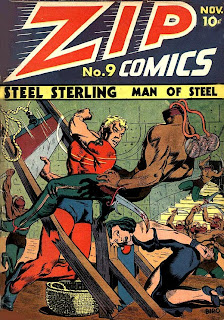DC responded with... Jimmy Olsen.

Now, you can probably see the problem here already. James Bond was suave, cultured, handsome and the epitome of cool. Whereas Jimmy was naive, unsophisticated, homely and as square as the Bizarro World.
The story (from Jimmy Olsen #89, December 1965) starts with Jimmy and Lucy on a date to see a movie featuring "Jamison Baird, Agent .003". As was common in the DC universe, things were changed just enough to avoid lawsuits, although it seems a bit odd in this case. DC had published a story featuring James Bond only a few years earlier (Showcase #43).
As Jimmy and Lucy watch the movie, he provides running commentary about the gimmicks that Bond--errr, Baird--uses in the movie. After the show, they see a man get shot trying to escape from a ship. He dies on shore, but not before he gives Jimmy a clue. Tell Superman to find a Doctor Juarez in the Latin America country of Andulia.
But in his typically zany fashion, Jimmy decides to become a secret agent himself and pursue this great mystery on his own. He comes up with a kit full of gimmicks and dubs himself Secret Agent Double-5, because... try not to laugh now, both his first and last names have five letters.
Jimmy shows up in Latin America, where a comely senorita gives him a very friendly greeting:

Hey, maybe there's something to be said for this secret agenting business. But of course she tries to kill him:

This gives Jimmy a chance to use his "parachute flashlight", one of the gimmicks he created. It somehow doesn't get ripped out of his hands when it deploys.
He changes his hair color, but now that he's in Latin America he needs something more of a disguise than his green suit and red bow-tie, so he does the noble thing:

Say what? Jimmy stealing clothes from a "peon"? Couldn't they have had him dropping a fiver in front of the poor guy? Terrible characterization, and even worse the poncho disguise works for about five seconds. Jimmy's thrown in a cell with another lovely senorita (one admires the unisex nature of Latin American prisons), and they escape as shown in the splash panel at the top. But of course, she betrays him as well (this spy business is starting to resemble my love life in college), and so he must escape yet again using one of his gimmicks:

Jimmy and Superman eventually solve the mystery, and free Dr Juarez, who turns out to have been working on an artificial heart that the dictator of his country wanted because it would let him rule for another hundred years as a despot. And in the end, Jimmy encounters another "dazzler":

It is this constant tension between the notion of Jimmy as the hero of his magazine, and yet a buffoonish teenager like Archie that creates some of the charm of the Silver Age Jimmy Olsen. They would show him being ultra-competent in one panel and goofing off in the next; gee, can't imagine how that might resonate with adolescents. ;)
Well, Agent Double-Five returned in Jimmy Olsen #92, and this time they showed him kicking some pretty iconic DC superhero butt:

An agent of S.C.A.R. has broken into Jimmy's apartment. But our hero reveals one use for his bow-tie:

I'd try to explain this story but it's virtually incomprehensible. Jimmy catches his double trying to burgle the apartment, then pretends to be the double, then encounters the Robin double who warns him to stay away from a particular location before being disintegrated, where of course Jimmy immediately heads and gets an operation that puts a deadly device in him like the one that killed Robin. Errr, the Robin double. And there are Superman, Supergirl and Batman doubles as well, but they're just basic crooks with similar features, which explains the front cover when they fight him, but the main villain, an alien, (who calls himself Nero) wants to burn the Planet Earth. Jimmy manages to save civilization by preventing Nero from killing the ersatz double superheroes.
































